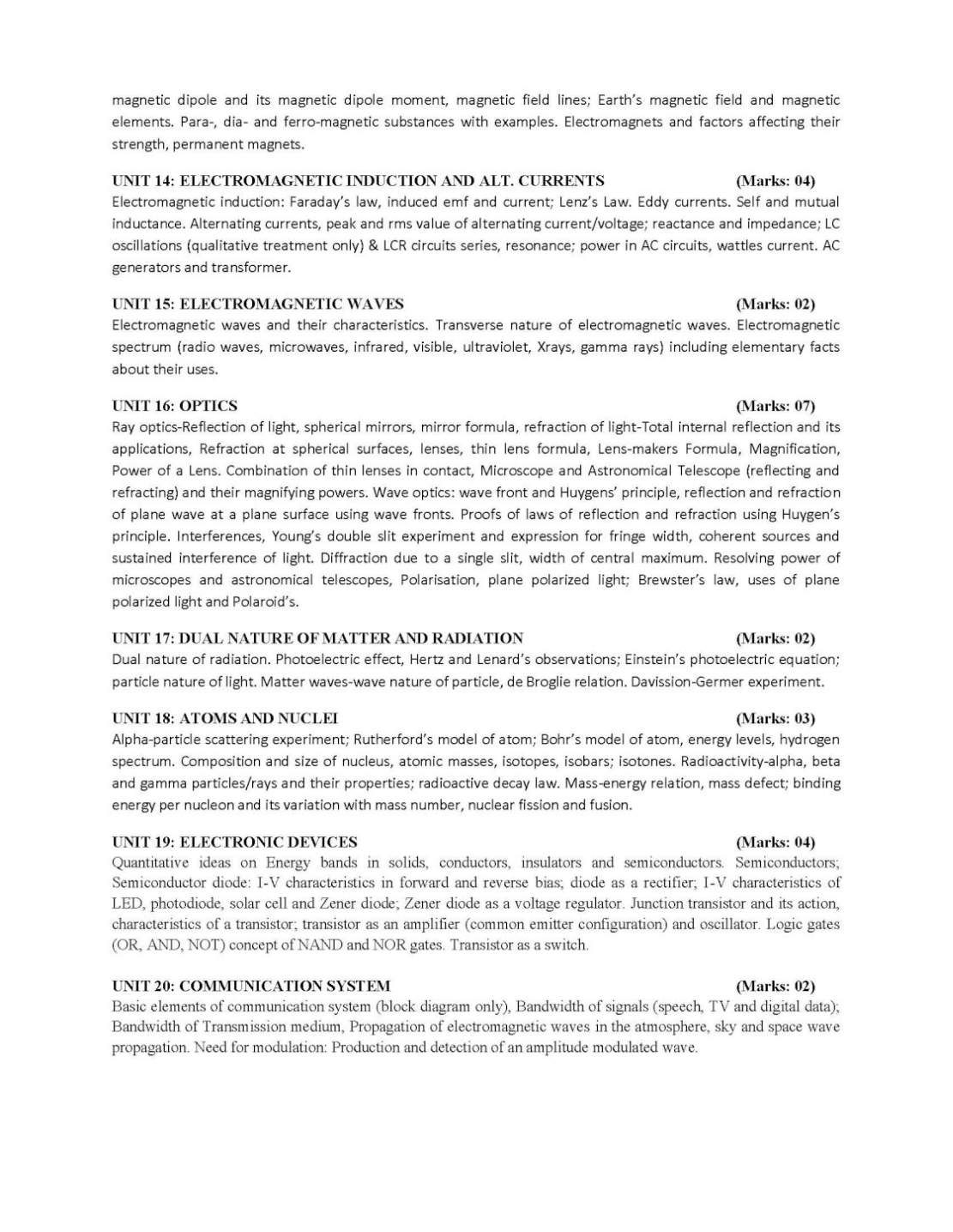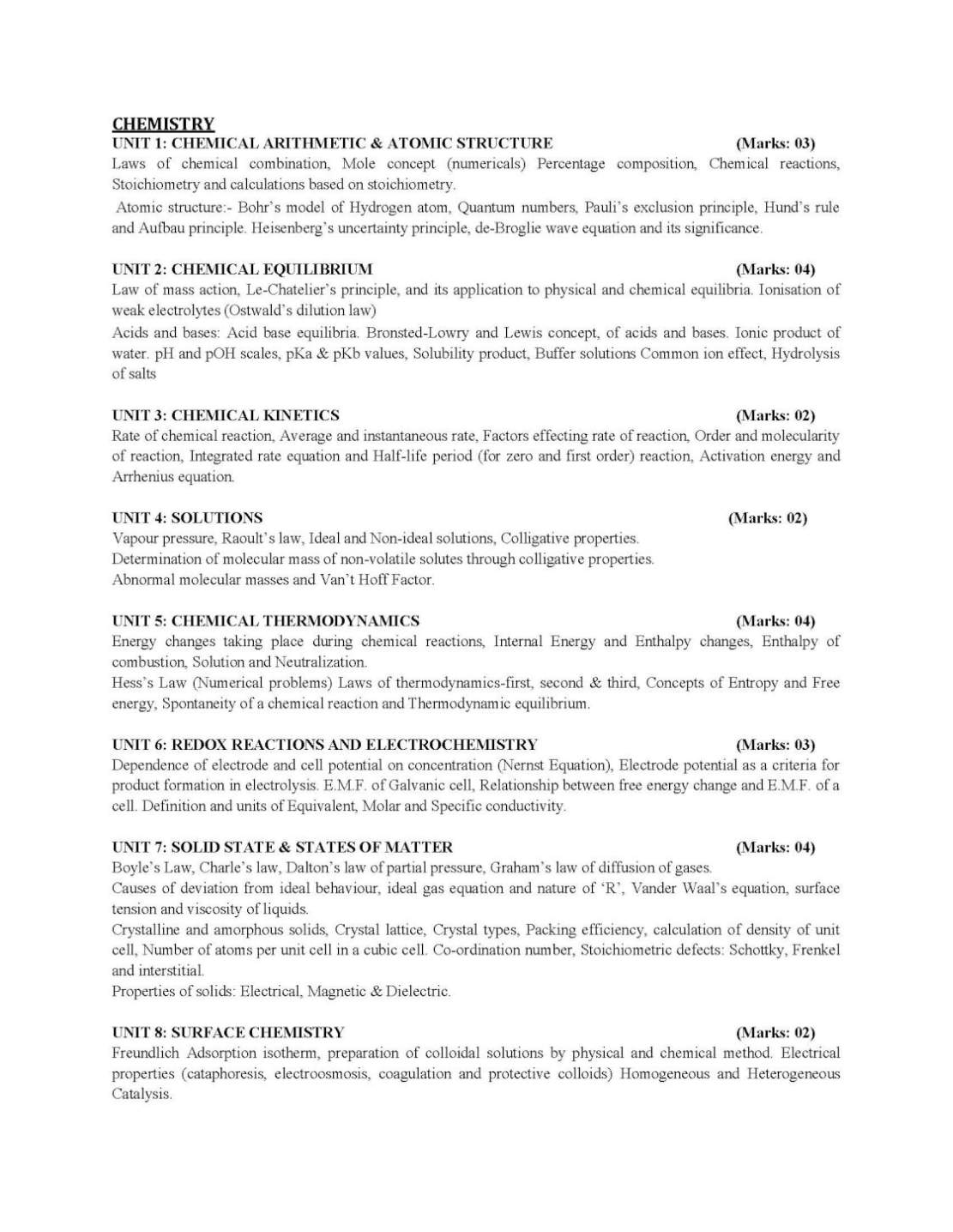|
#2
20th August 2015, 12:11 PM
| |||
| |||
| Re: JKBOPEE CET syllabus
As you want to get the syllabus of Jammu and Kashmir Common Entrance Test so here is the information of the same for you: PHYSICS UNIT 1: PHYSICAL WORLD AND MEASUREMENT S I units, Fundamental and derived units. Accuracy and precision of measuring instruments, Errors in measurement, Significant figures. Dimensions of Physical quantities, dimensional analysis and its applications. UNIT 2: KINEMATICS: Motion in a straight line: Position-time graph, speed and velocity. Elementary concepts of differentiation and integration for describing motion. Uniform and non-uniform motion, average speed and instantaneous velocity. Uniformly accelerated motion, velocity-time graph, position-time graphs, relations for uniformly accelerated motion, (graphical treatment and calculus approach). Scalar and Vector quantities, addition and Subtraction of vectors, general Vector and notation, Relativen Velocity. Scalar and Vector products of two vectors with properties, Unit Vector, Resolution of a Vector in plane rectangular components, Motion in a plane, Projectile Motion. UNIT 3: LAWS OF MOTION: Concept of force and Inertia, Newton‘s First Law of motion; Momentum and Newton‘s Second Law of motion, Impulse; Newton‘s Third Law of motion. Law of conversation of linear momentum and its applications, Equilibrium of concurrent forces. Friction, static and kinetic friction, laws of friction, rolling friction. Dynamics of uniform circular motion: Centripetal force and examples of circular motion (vehicle on level circular road, vehicle on banked road.) UNIT 4: WORK, ENERGY AND POWER: Concept of scalar products of vectors, Work done by a constant force and variable force; kinetic energy, work energy theorem, power. Potential energy, Potential energy of spring, conservative forces, conservation of mechanical energy (K.E. and P.E.), non-conservative forces; Elastic and inelastic collisions in one and two dimensions. UNIT 5: MOTION OF SYSTEM OF PARTICLES AND RIGID BODY: Centre of mass of a two-particle system, Centre of mass of a rigid body; Concepts of vector product of vectors: moment of a force, torque, angular momentum, conservation of angular momentum with some examples. Moment of inertia, radius of gyration. Values of moment of inertia for simple geometric objects (no derivation), statement of parallel and perpendicular axes theorems and their applications. Rigid body rotation and equations of rotational motion. UNIT 6: GRAVITATION: The universal law of gravitation. Acceleration due to gravity and its variation with altitude, depth and shape, Kepler’s laws of planetary motion. Gravitational potential; gravitational potential energy. Escape velocity. Orbital velocity of satellite. Geo-stationary satellites. UNIT 7: PROPERTIES OF BULK MATTER: Elastic behavior, Stress-strain relationship. Hooke‘s Law, Young‘s modulus, bulk modulus, shear modulus of rigidity. Pressure due to a fluid column; Pascal‘s law and its applications (hydraulic lift and hydraulic brakes) Viscosity, Stokes‘ law, terminal velocity, streamline and turbulent flow, Reynolds number. Bernoulli‘s theorem and its applications Surface energy and surface tension, angle of contact, applications of surface tension – ideas to drops, bubbles and capillary rise. Heat, temperature, thermal expansion; specific heat, calorimetry; change of state-latent heat. Heat transfer-conduction, convection and radiation, Newton‘s law of cooling. UNIT 8: THERMODYNAMICS: Thermal equilibrium and definition of temperature (zeroth law of thermodynamics),. Heat work and internal energy. First law of thermodynamics. Second law of thermodynamics: reversible and irreversible processes. Heat engines and refrigerators (concept only) UNIT 9: BEHAVIOUR OF PERFECT GAS AND KINECTIC THEORY: Equation of state of a perfect gas, work done on compressing a gas. Kinectic theory of gases – assumptions, concept of pressure. Kinectic energy and temperature: rms speed of gas molecules; Degrees of freedom, Law of equipartition of energy (Statement only) and applications to specific heat capacities of gases; concept of Mean free path, Avagadro’s number UNIT 10: OSCILLATIONS AND WAVES: Periodic motion – Period, frequency, displacement as a function of time. Periodic functions. Simple harmonic motion (S.H.M.) and its equation; phase; oscillations of a spring-restoring force and force constant; energy in S.H.M. – kinetic and potential energies; Simple pendulum-derivation of expression for its time period; Free, forced and damped oscillations, resonance. Wave motion. Longitudinal and transverse waves, speed of a wave. Displacement relation for a progressive wave. Principle of superposition of waves, reflection of waves, Standing waves in strings and organ pipes, fundamental mode and harmonics, Beats, Doppler effect. UNIT 11: ELECTROSTATICS: Electric charges: Conservation of charge, Coulomb’s law-forces between two point charges, forces between multiple charges; superposition principle and continuous charge distribution. Electric field: Electric field due to a point charge, Electric field lines, Electric dipole, Electric field due to a dipole, Torque on a dipole in uniform electric field. Electric flux, Statement of Gauss’s theorem and its applications to find field due to infinitely long straight wire, uniformly charged infinite plane sheet and uniformly charged thin spherical shell (field inside and outside). Electric potential, electric potential due to a point charge, a dipole and system of charges; Equipotential surfaces, Electrical potential energy of a system of two point charges and of electric dipole in an electrostatic field. Conductors and insulators, Dielectrics and electric polarization, capacitor and capacitance, combination of capacitors in series and in parallel, capacitance of parallel plate capacitor with and without dielectric medium between the plates, Energy stored in a capacitor. Van de Graff generator. UNIT 12: CURRENT ELECTRICITY: Electric current, Drift velocity, Ohm’s law, Electrical resistance, V-I characteristics (linear & non-linear), Electrical energy and power, Electrical resistivity and conductivity, Carbon resistors, Colour code for carbon resistors; Temperature dependence of resistance. Internal resistance of a cell, potential difference and emf of a cell, combination of cells in series and in parallel. Kirchhoff’s laws and their applications. Wheatstone bridge, Metre bridge. Potentiometer – principle and its application to measure the potential difference and for comparing e.m.f. of two cells; measurement of internal resistance of a cell. UNIT 13: MAGNETIC EFFECTS OF CURRENT AND MAGNETISM: Biot – Savart law and its application to current carrying circular loop. Ampere’s law and its applications to infinitely long current carrying straight wire, straight and toroidal solenoids. Force on moving charge in uniform magnetic and electric fields. Cyclotron. Force on a current-carrying conductor in a uniform magnetic field. Force between two parallel current-carrying conductors-definition of ampere. Torque experienced by a current loop in uniform magnetic field; Moving coil galvanometer, its current sensitivity and conversion with examples. Current loop as a magnetic dipole and its magnetic dipole moment, magnetic field lines; Earth’s magnetic field and magnetic elements. Para-, dia- and ferro-magnetic substances with examples. Electromagnets and factors affecting their strength, permanent magnets. UNIT 14: ELECTROMAGNETIC INDUCTION AND ALT. CURRENTS: Electromagnetic induction: Faraday’s law, induced emf and current; Lenz’s Law. Eddy currents. Self and mutual inductance. Alternating currents, peak and rms value of alternating current/voltage; reactance and impedance; LC oscillations (qualitative treatment only) & LCR circuits series, resonance; power in AC circuits, wattles current. AC generators and transformer UNIT 15: ELECTROMAGNETIC WAVES: Electromagnetic waves and their characteristics. Transverse nature of electromagnetic waves. Electromagnetic spectrum (radio waves, microwaves, infrared, visible, ultraviolet, Xrays, gamma rays) including elementary facts about their uses. UNIT 16: OPTICS: Ray optics-Reflection of light, spherical mirrors, mirror formula, refraction of light-Total internal reflection and its applications, Refraction at spherical surfaces, lenses, thin lens formula, Lens-makers Formula, Magnification, Power of a Lens. Combination of thin lenses in contact, Microscope and Astronomical Telescope (reflecting and refracting) and their magnifying powers. Wave optics: wave front and Huygens’ principle, reflection and refraction of plane wave at a plane surface using wave fronts. Proofs of laws of reflection and refraction using Huygen’s principle. Interferences, Young’s double slit experiment and expression for fringe width, coherent sources and sustained interference of light. Diffraction due to a single slit, width of central maximum. Resolving power of microscopes and astronomical telescopes, Polarisation, plane polarized light; Brewster’s law, uses of plane polarized light and Polaroid’s. UNIT 17: DUAL NATURE OF MATTER AND RADIATION: Dual nature of radiation. Photoelectric effect, Hertz and Lenard’s observations; Einstein’s photoelectric equation; particle nature of light. Matter waves-wave nature of particle, de Broglie relation. Davission-Germer experiment. UNIT 18: ATOMS AND NUCLEI: Alpha-particle scattering experiment; Rutherford’s model of atom; Bohr’s model of atom, energy levels, hydrogen spectrum. Composition and size of nucleus, atomic masses, isotopes, isobars; isotones. Radioactivity-alpha, beta and gamma particles/rays and their properties; radioactive decay law. Mass-energy relation, mass defect; binding energy per nucleon and its variation with mass number, nuclear fission and fusion. UNIT 19: ELECTRONIC DEVICES: Quantitative ideas on Energy bands in solids, conductors, insulators and semiconductors. Semiconductors; Semiconductor diode: I-V characteristics in forward and reverse bias; diode as a rectifier; I-V characteristics of LED, photodiode, solar cell and Zener diode; Zener diode as a voltage regulator. Junction transistor and its action, characteristics of a transistor; transistor as an amplifier (common emitter configuration) and oscillator. Logic gates (OR, AND, NOT) concept of NAND and NOR gates. Transistor as a switch. UNIT 20: COMMUNICATION SYSTEM: Basic elements of communication system (block diagram only), Bandwidth of signals (speech, TV and digital data); Bandwidth of Transmission medium, Propagation of electromagnetic waves in the atmosphere, sky and space wave propagation. Need for modulation: Production and detection of an amplitude modulated wave.     For more detailed information I am uploading a PDF file which is free to download: |